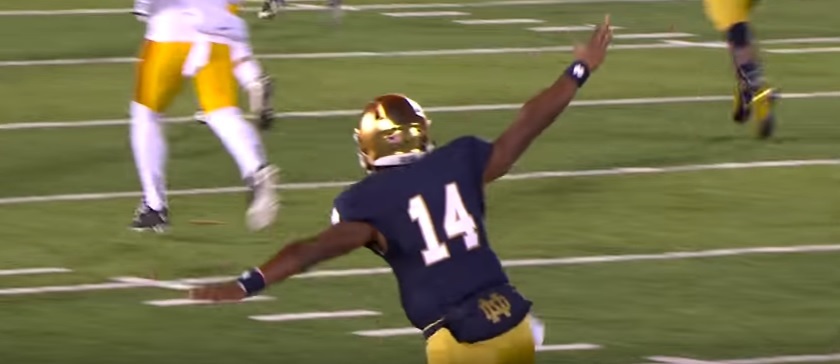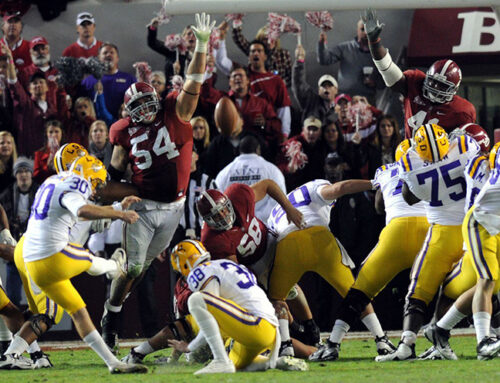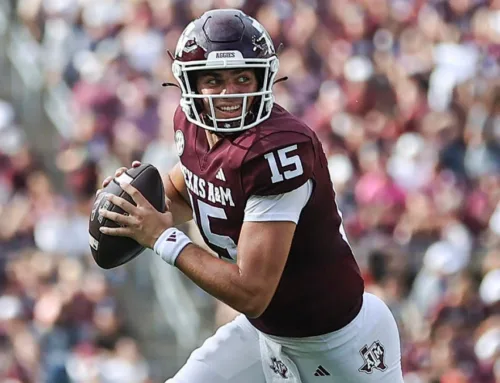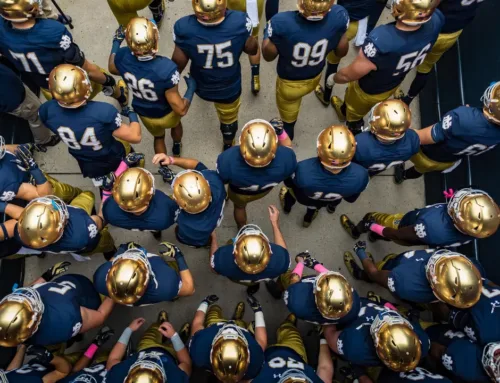Notre Dame played incredibly explosive football in 2015 – both in reeling off multiple “chunk” plays per game on offense and giving up a ton of long touchdowns on defense. In the first of a series of breakdowns on Notre Dame’s “Five Factors” stats, can we expect those numbers to get better or worse in 2016?
Background: For those unfamiliar, most numbers included come from Bill Connelly’s S&P+ and Brian Fremeau’s FEI statistics – glossary of S&P+ terms here, and more efficiency stats at bcftoys.com. As always, ask away in the comments on any questions as well.
Offense:
Short version: It’ll be hard to get better, because 2015 was freaking awesome.
2015 Ranks: #4 in IsoPPP+ (S&P+), #3 in Explosive Drive Rate (FEI)
HIGHLIGHT ALERT:
See the LONGEST play from scrimmage in ND history – a 98-yard run by true Frosh Josh Adams. pic.twitter.com/FMf2xRTLVP— Notre Dame Football (@NDFootball) November 14, 2015
How can it get better?
In 2015, “big chunk” plays seemed to be a glorious, every-week occurrence. The numbers aren’t as insane since the Irish play at a snail’s pace compared to the hurry-up, no huddle offenses that are in vogue (106th in adjusted pace), but the 2015 Fig Things were more explosive than Baylor, Oregon, or Oklahoma. Remember when the longest rush of the Charlie Weis era was a 58-yard Brady Quinn scramble? There were five touchdown runs of 62+ yards last season, and those come from three different rushers (Adams had 3; one each for Prosise and Kizer). In short, it’s going to be really, really, ridiculously hard to get much better – maintaining this explosion is the achievable goal.
Still, despite losing four key members of the rushing game (Prosise/Stanley/Martin/Elmer) to professional careers, it’s not a stretch to believe the explosive running game will remain just as dangerous. Josh Adams was a revelation as a true freshman, and actually averaged more highlight yards per opportunity (7.8) than Prosise (6.9). (Quick background: highlight yards measure essentially what you gain as a runner in the open field with good blocking.) It’s a testament to Harry Hiestand and the incredible recruiting hauls of the past few classes that there seems to be very little concern in the Gug in their ability to replace three starters on the offensive line.
Performance at quarterback, both in the running and passing attack, should only improve with more experience for DeMalik Kizaire. Yes, I’m hedging bets on the QB competition here, but both Kizer and Zaire have shown strong foundational traits that lead to explosive plays. Each can run the zone read effectively, scramble for first down yardage and more when given some open field, and throw the deep ball extremely well. Another year working with Brian Kelly and Mike Sanford should also help the starter better identify holes in coverage and get the offense into the right plays – Kizer in particular had a few missed receivers open downfield last season that maybe with another year of experience he connects with in 2016.
Why could it get worse?
Fuller, Mr. Esplosiva himself, is impossible to replace with his absurd 20.3 yards per catch (Note: With him, the “ESPOSIVA-ness” title is temporarily suspended). Who can take over that role as the deep threat over the top? Torii Hunter Jr. is immensely talented, but doesn’t have Fuller’s speed and acceleration (hint: no one in college football does).
With no one player looming as such a clear deep threat, it’s going to take a portfolio approach to beat defenses deep – at least two or three of Hunter, Corey Holmes, Alize Jones, CJ Sanders, Kevin Stepherson, and Equanimeous St. Brown likely need to take significant leaps forward. The group has a ton of upside, but it’s a lot to expect of receivers that combined last season for just nine catches of 20+ yards (Fuller had 21 by himself) and includes five players that have caught less than two passes in their young careers.
Looking at the running backs, Prosise’s versatility will also be difficult to replace – he was targeted as a receiver on approximately 10% of his snaps compared to just 2% for Adams. Folston provides more experience as a receiver and blocker, but sacrifices explosiveness compared to the other backs. In 2014 Folston averaged just 3.54 highlight yards per opportunity, which ranked 153rd out of the 177 running backs in FBS with at least 100 carries. Dexter Williams has the tools to be extremely explosive and seemed to have a great spring, but had just three carries of eight yards or more last season in 21 attempts.
While the offense should remain explosive, there are too many key losses and unproven players replacing them to remain in the top five in the country unless everything breaks just right. The offense should be just fine with a slight drop-off in explosiveness with marginal improvement in other areas like efficiency and (stay tuned for more on these areas).
Projection: Slight decline to #5-15 nationally
Defense:
2015 Ranks: #55 IsoPPP+ (S&P+), #67 in Explosive Drive Rate (FEI)
The big plays given up last season were incredibly frustrating but not an outlier for Brian Van Gorder at Notre Dame – 2015 was actually a slight improvement over 2014. Qualitatively, though, it was so much worse to watch, since the defense would show flashes of brilliance, stringing together a few three-and-outs in a row, and then a flea flicker or missed assignment (or tackle) would turn into a backbreaking, soul-sucking long touchdown.
Van Gorder’s scheme is generally predicated on confusion and aggression, which in turn leads to pain of the highest degree when assignments are failed or things break down. So when his boss is reviewing tape this offseason and this problem keeps coming back up, how does BVG address it?
How can it get better?
The simplest and probably least likely answer is a shift in defensive philosophy – moving from some degree towards some “bend but don’t break” conservatism. There’s a number of different ways this could come about – bringing less pressure or bringing it less often, simplifying the number of things you’re asking defenders to do, simplifying when you ask them to do it (how much changes between the play call and pre-snap), or just bringing more consistency and continuity to week to week assignments.
Complexity has been the hot-button criticism of Van Gorder and his scheme, but there are a number of underlying assumptions there no one seems to have validated about what exactly (or what combination) is too complex. At a high level it just seems like most Sunday morning quarterbacks (and some close to the program) feel like Van Gorder is asking too much of his players, and even small changes to reduce their mental workload could be beneficial in preventing breakdowns.
From a personnel standpoint, it’s damn hard to lose arguably the best player from every level of your defense and improve. Notre Dame was equally bad giving up explosive plays on the ground and in the air, but the secondary seemed to be the most responsible culprit if you had to pick a personnel group from a lineup. The Irish gave up 11 plays of over 40 yards (seven for touchdowns), and a lot of them involved safeties and cornerbacks falling for misdirection or taking bad angles that turned first downs into touchdowns.
The good news is that there should be new blood in the secondary – Cole Luke returns, but with KeiVarae Russell, Matthias Farley, and Elijah Shumate gone, we’ll get to see how disciplined Drue Tranquil, Shaun Crawford, Devin Butler, and a boatload of underclassmen can be. Max Redfield could certainly have the lightbulb click in his final year, Maurice Stovall-style (no relation), or could be on a short leash before turning things to true freshman Devin Studstill if spring practice reps are any indication.
How can it get worse?
Just like with the offense, there’s not much room to go, just in the opposite direction!
The easy answer is that bad things, like blown assignments or lack of discipline on trick plays, remain the same without some of the veteran playmakers of 2015 there to save their butts. The secondary may feature new faces, but if Van Gorder’s scheme remains aggressive and fairly complex, can we really be optimistic that some freshmen and sophomore will step in and get it right away?
It’s hard to read too much into offseason coach-speak, but the stated solutions to the Big Plays Problem (BPP) sound something like “do better” and “execute the way we want” versus any kind of thorough re-examination of the defensive philosophy. There’s still not a lot of reasons for optimism for the Irish pass rush, which would help minimize the time the suspect secondary needs to hold up. In two years Van Gorder’s aggressiveness hasn’t translated into success sacking opponents or forcing turnovers, just in forcing punts.
Still, while the defense loses its biggest names, it returns a lot of the 2015 two-deep. Let’s start drinking the Kool Aid for a second- would it be a shock if the return of Jarron Jones, coupled with more experience for Jerry Tillery, Isaac Rochell, and Daniel Cage, actually shored up the run defense? Could every angry message board critic be right, and losing Joe Schmidt is actually addition by subtraction? Maybe more inexperience in his unit leads Van Gorder to a more conservative approach that’s closer to what the Irish should have been doing schematically all along.
This may be optimistic, but I have to believe that the defense will be feeling the pressure to reduce big plays given up in 2016, and that emphasis over the offseason will lead to improvement even with the loss of 2015’s best defenders. I would have trick plays going on a non-stop loop as a screensaver on BVG’s computer if I was Brian Kelly as a constant reminder – maybe for defensive players too.
The offenses on the 2016 schedule also don’t feature some of the veteran quarterbacks of last season – goodbye Keenan Reynolds, Deshaun Watson, Cody Kessler, and Kevin Hogan, and welcome to Brad Kaaya and a whole bunch of guys that haven’t started a game. I’m a believer in Crawford, Tranquill, and an answer in some form at free safety enough to believe this is an area Notre Dame can improve. The big question – can this improvement take place without a trade-off in limiting efficiency?
Projection: Slight improvement to #40-50 nationally





Great start to the new site. I certainly cannot see how we can maintain our offensive explosion losing Fuller and 3 starters on the OL. I know Heistand is acting like it is plug and play, and I would love it to be, but I am much more cautious on that being true. Even so, the slight drop you predict is a very reasonable prediction and would make for a very happy result on offense.
On defense, I have to go another way. These young guys have been in the system long enough, and as you point out, enough of the two-deep is returning, I have to hold out hope that we see more than just a slight improvement. I know we lost Jaylon, but I think this is the year BVG has to show he knows how to coach college kids and defend college offenses.
Yes, we need to keep hope alive now, in the offseason, otherwise we’ll never have any hope.
I have to say I am troubled by the staff’s apparent “Stay the Course” approach to (non)fixing the defense. But given the slate of offenses/qb’s we face next year, we may be significantly better without actually being any better. Which I guess I’d take after last year. Yes I’d definitely take that after last year. If we get a 2012-like boost from a schedule full of middling to marginal offensive teams I’ll take that in a heartbeat. It’s fine until we Ohio State in a bowl game.
Hey maybe the system will click in year 3 am I right guys?
Ugh, I was having such a nice offseason not thinking about BVG and his garbage defense…
Isn’t it likely too that the lack of explosiveness with Fuller gone will inhibit the explosiveness of the running game? i.e. didn’t Fuller give the running game more space with his being a deep threat? Or is it sufficient if the WR’s/TE’s demand enough attention (one of them needs to be doubled e.g.) then it shouldn’t affect the running game too much?
It definitely could, although I think traditionally you’d see it go the other way – running softening up the back end for explosive passes when lbs and safeties start cheating up. It could limit it if the defense isnt respecting the deep ball, but with Kizer and fast/talented wrs (and deep routes – the offense will remain full of combo routes as opposed to moving to quicker hits unless things go south quickly), then I think the impact is probably pretty small.
Good to know. So in part last year was just a KILLER combo with a great running game and a guy (Fuller) who could run by anybody taking advantage of the open space. The running game will keep humming along (hopefully) and will give the young athletes a chance to make plays in the passing game.
There were actually some indications during spring ball of BVG ratcheting it down a bit – I can’t remember off the top of my head because it got (to my feeble football mind) really complicated, but the gist was that the safeties’ responsibilities are considerably less. If I remember right, it was something like there’s less “run fill to the outside if you see this, run fill to the lane if you see this, rotate to the field if you see this, double the slot if you see this, ready? go!” and more “in this situation, FS, you have deep zone and run help left, SS, you have run help right.” I’m sure that’s dramatically over-simplified, but…
The other thing I would add is that, for all the condemnations of BVG and his super-complicated system, a true freshman came into spring ball and did just fine at FS, which supposedly is the PhD position in this defense. I think there’s a substantial probability here that Max just isn’t up to being a top-level starting FS, and I submit the 85-yard BC touchdown scramble as Exhibit A. That was about his 25th game, and he made a humongous mistake of the most basic variety for a safety. Shouldn’t ever happen. I wouldn’t go so far as to say he spaces out – I think he’s in the game all the time – I think he just doesn’t have a knack for maintaining his responsiblities.
With all apologies to Kei, I’m not so sure the secondary lost its best player last year. Day is definitely a huge loss but I don’t think an irreplaceable one, especially if Jones stays healthy.
I think the big question with the linebackers, given that Onwualu is back, is whether (Morgan AND (Martini OR Barajas)) >= (Jaylon AND Schmidt). I don’t know if that’s true, but it’s infinitely more probable than Player X >= Jaylon.
Also, great write up Mike!